CIPD Level 5 Diploma in HRM - Developing Professional Practices Report
VerifiedAdded on 2022/09/28
|19
|5486
|19
Report
AI Summary
This report delves into the multifaceted realm of HR professionalism, examining its core tenets and practical applications. It initiates with a definition of HR professionalism, emphasizing the importance of expertise, ethical conduct, and adherence to professional standards. The report then explores strategies for ensuring effectiveness and efficiency within the HR function, highlighting the role of self-assessment, data analytics, and automation in optimizing HR operations. A significant portion of the report is dedicated to the CIPD Professionalism for the Future Framework (PFF) and the CIPD Code of Professional Conduct, elucidating their usefulness in guiding professional development and upholding ethical standards. The CIPD framework is presented as a valuable tool for continuous learning, skill enhancement, and adaptation to evolving business environments, while the Code of Conduct is examined in terms of its four key areas: professional competence, representation of the profession, ethical standards, and stewardship. The report integrates relevant literature to support its arguments, culminating in a comprehensive overview of HR professionalism and its practical implications.
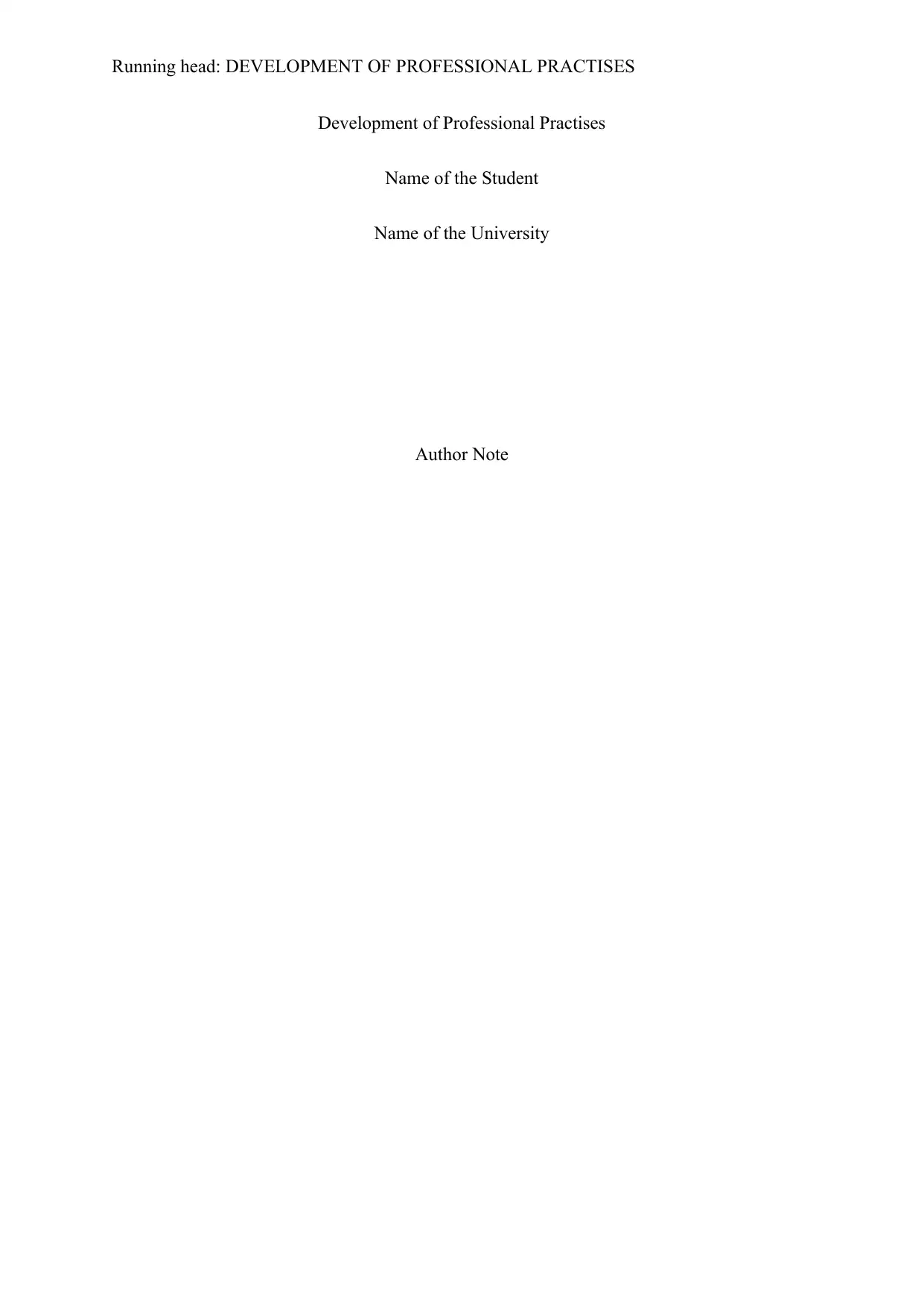
Running head: DEVELOPMENT OF PROFESSIONAL PRACTISES
Development of Professional Practises
Name of the Student
Name of the University
Author Note
Development of Professional Practises
Name of the Student
Name of the University
Author Note
Paraphrase This Document
Need a fresh take? Get an instant paraphrase of this document with our AI Paraphraser
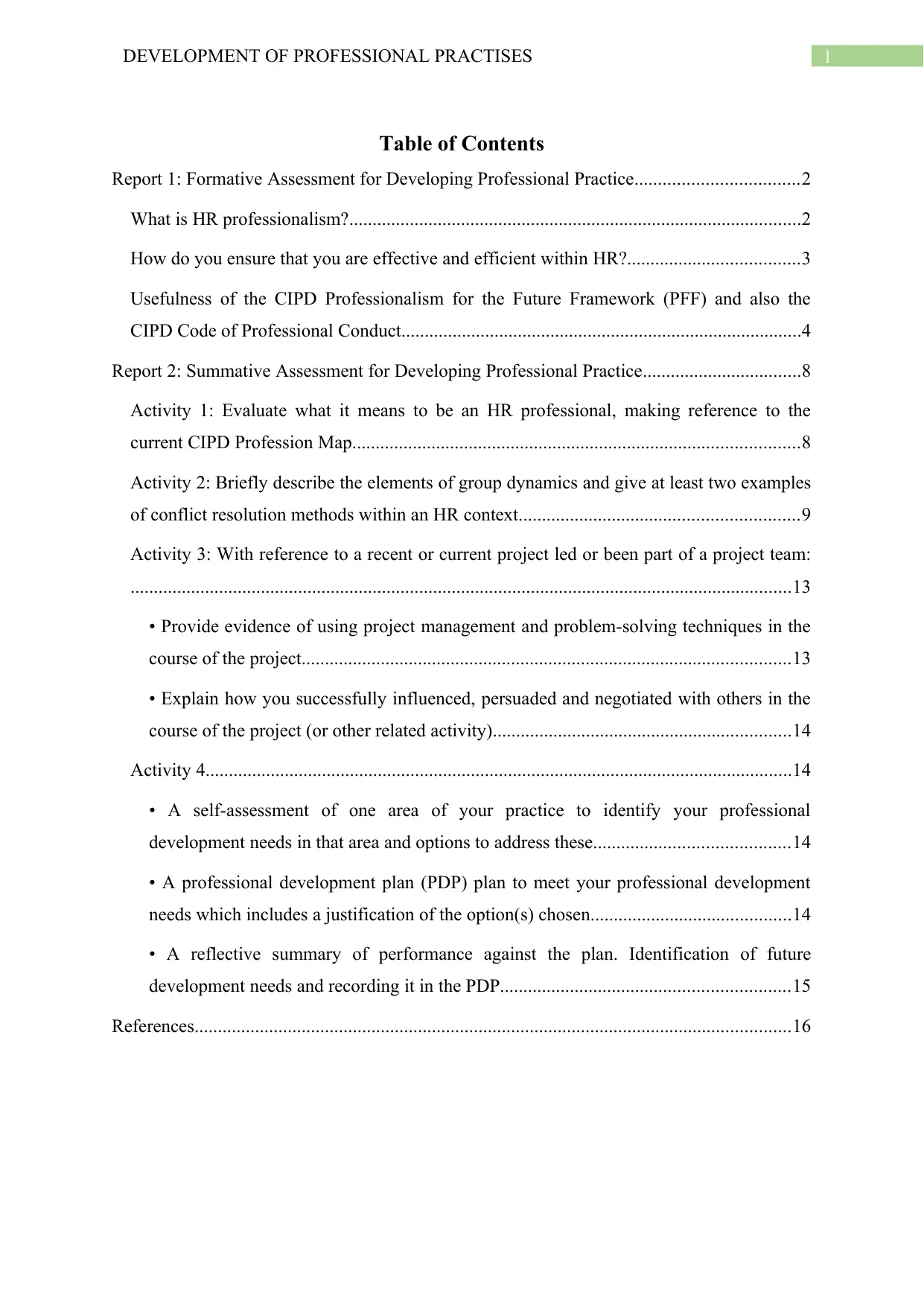
1DEVELOPMENT OF PROFESSIONAL PRACTISES
Table of Contents
Report 1: Formative Assessment for Developing Professional Practice...................................2
What is HR professionalism?.................................................................................................2
How do you ensure that you are effective and efficient within HR?.....................................3
Usefulness of the CIPD Professionalism for the Future Framework (PFF) and also the
CIPD Code of Professional Conduct......................................................................................4
Report 2: Summative Assessment for Developing Professional Practice..................................8
Activity 1: Evaluate what it means to be an HR professional, making reference to the
current CIPD Profession Map................................................................................................8
Activity 2: Briefly describe the elements of group dynamics and give at least two examples
of conflict resolution methods within an HR context............................................................9
Activity 3: With reference to a recent or current project led or been part of a project team:
..............................................................................................................................................13
• Provide evidence of using project management and problem-solving techniques in the
course of the project.........................................................................................................13
• Explain how you successfully influenced, persuaded and negotiated with others in the
course of the project (or other related activity)................................................................14
Activity 4..............................................................................................................................14
• A self-assessment of one area of your practice to identify your professional
development needs in that area and options to address these..........................................14
• A professional development plan (PDP) plan to meet your professional development
needs which includes a justification of the option(s) chosen...........................................14
• A reflective summary of performance against the plan. Identification of future
development needs and recording it in the PDP..............................................................15
References................................................................................................................................16
Table of Contents
Report 1: Formative Assessment for Developing Professional Practice...................................2
What is HR professionalism?.................................................................................................2
How do you ensure that you are effective and efficient within HR?.....................................3
Usefulness of the CIPD Professionalism for the Future Framework (PFF) and also the
CIPD Code of Professional Conduct......................................................................................4
Report 2: Summative Assessment for Developing Professional Practice..................................8
Activity 1: Evaluate what it means to be an HR professional, making reference to the
current CIPD Profession Map................................................................................................8
Activity 2: Briefly describe the elements of group dynamics and give at least two examples
of conflict resolution methods within an HR context............................................................9
Activity 3: With reference to a recent or current project led or been part of a project team:
..............................................................................................................................................13
• Provide evidence of using project management and problem-solving techniques in the
course of the project.........................................................................................................13
• Explain how you successfully influenced, persuaded and negotiated with others in the
course of the project (or other related activity)................................................................14
Activity 4..............................................................................................................................14
• A self-assessment of one area of your practice to identify your professional
development needs in that area and options to address these..........................................14
• A professional development plan (PDP) plan to meet your professional development
needs which includes a justification of the option(s) chosen...........................................14
• A reflective summary of performance against the plan. Identification of future
development needs and recording it in the PDP..............................................................15
References................................................................................................................................16
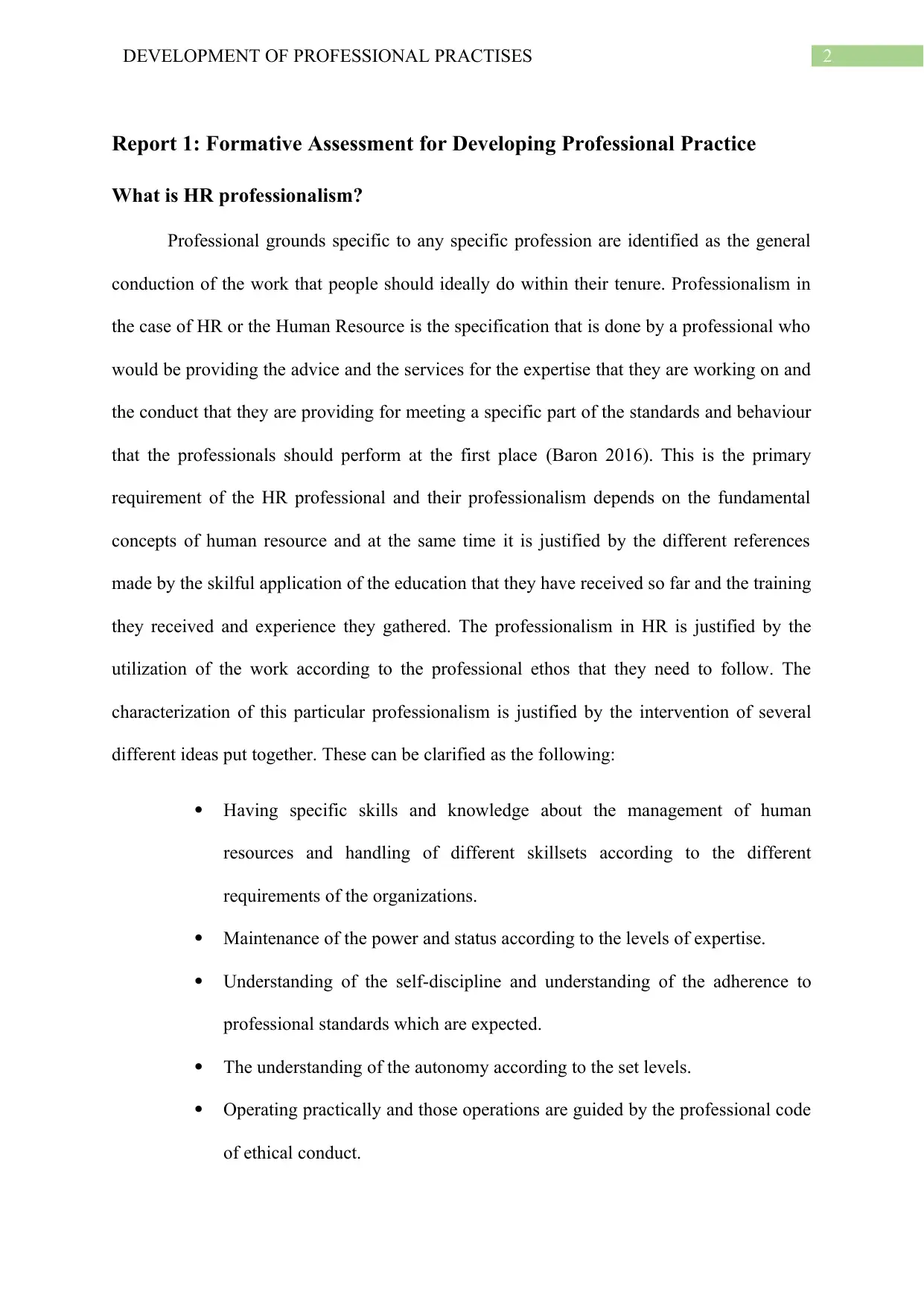
2DEVELOPMENT OF PROFESSIONAL PRACTISES
Report 1: Formative Assessment for Developing Professional Practice
What is HR professionalism?
Professional grounds specific to any specific profession are identified as the general
conduction of the work that people should ideally do within their tenure. Professionalism in
the case of HR or the Human Resource is the specification that is done by a professional who
would be providing the advice and the services for the expertise that they are working on and
the conduct that they are providing for meeting a specific part of the standards and behaviour
that the professionals should perform at the first place (Baron 2016). This is the primary
requirement of the HR professional and their professionalism depends on the fundamental
concepts of human resource and at the same time it is justified by the different references
made by the skilful application of the education that they have received so far and the training
they received and experience they gathered. The professionalism in HR is justified by the
utilization of the work according to the professional ethos that they need to follow. The
characterization of this particular professionalism is justified by the intervention of several
different ideas put together. These can be clarified as the following:
Having specific skills and knowledge about the management of human
resources and handling of different skillsets according to the different
requirements of the organizations.
Maintenance of the power and status according to the levels of expertise.
Understanding of the self-discipline and understanding of the adherence to
professional standards which are expected.
The understanding of the autonomy according to the set levels.
Operating practically and those operations are guided by the professional code
of ethical conduct.
Report 1: Formative Assessment for Developing Professional Practice
What is HR professionalism?
Professional grounds specific to any specific profession are identified as the general
conduction of the work that people should ideally do within their tenure. Professionalism in
the case of HR or the Human Resource is the specification that is done by a professional who
would be providing the advice and the services for the expertise that they are working on and
the conduct that they are providing for meeting a specific part of the standards and behaviour
that the professionals should perform at the first place (Baron 2016). This is the primary
requirement of the HR professional and their professionalism depends on the fundamental
concepts of human resource and at the same time it is justified by the different references
made by the skilful application of the education that they have received so far and the training
they received and experience they gathered. The professionalism in HR is justified by the
utilization of the work according to the professional ethos that they need to follow. The
characterization of this particular professionalism is justified by the intervention of several
different ideas put together. These can be clarified as the following:
Having specific skills and knowledge about the management of human
resources and handling of different skillsets according to the different
requirements of the organizations.
Maintenance of the power and status according to the levels of expertise.
Understanding of the self-discipline and understanding of the adherence to
professional standards which are expected.
The understanding of the autonomy according to the set levels.
Operating practically and those operations are guided by the professional code
of ethical conduct.
⊘ This is a preview!⊘
Do you want full access?
Subscribe today to unlock all pages.

Trusted by 1+ million students worldwide
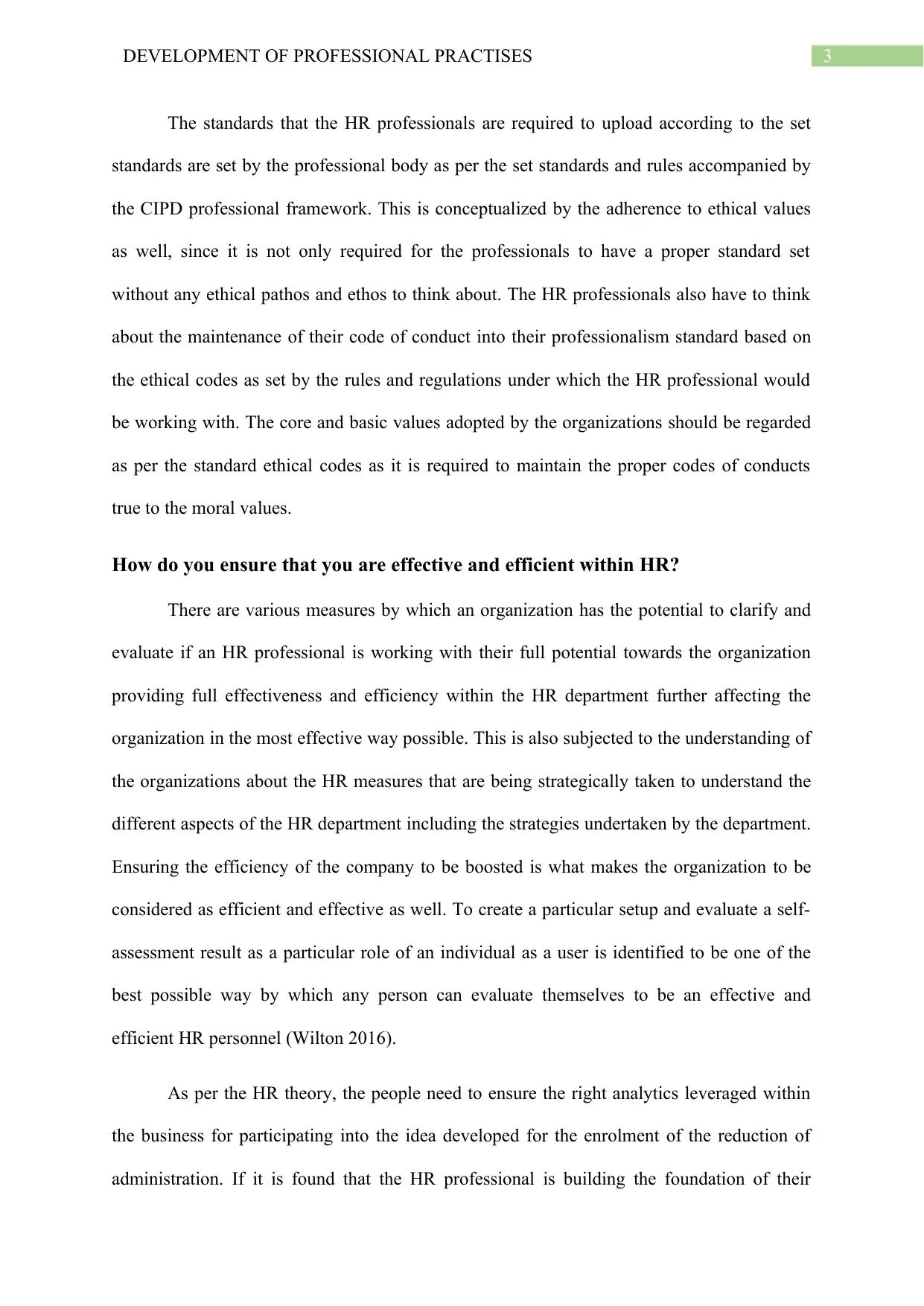
3DEVELOPMENT OF PROFESSIONAL PRACTISES
The standards that the HR professionals are required to upload according to the set
standards are set by the professional body as per the set standards and rules accompanied by
the CIPD professional framework. This is conceptualized by the adherence to ethical values
as well, since it is not only required for the professionals to have a proper standard set
without any ethical pathos and ethos to think about. The HR professionals also have to think
about the maintenance of their code of conduct into their professionalism standard based on
the ethical codes as set by the rules and regulations under which the HR professional would
be working with. The core and basic values adopted by the organizations should be regarded
as per the standard ethical codes as it is required to maintain the proper codes of conducts
true to the moral values.
How do you ensure that you are effective and efficient within HR?
There are various measures by which an organization has the potential to clarify and
evaluate if an HR professional is working with their full potential towards the organization
providing full effectiveness and efficiency within the HR department further affecting the
organization in the most effective way possible. This is also subjected to the understanding of
the organizations about the HR measures that are being strategically taken to understand the
different aspects of the HR department including the strategies undertaken by the department.
Ensuring the efficiency of the company to be boosted is what makes the organization to be
considered as efficient and effective as well. To create a particular setup and evaluate a self-
assessment result as a particular role of an individual as a user is identified to be one of the
best possible way by which any person can evaluate themselves to be an effective and
efficient HR personnel (Wilton 2016).
As per the HR theory, the people need to ensure the right analytics leveraged within
the business for participating into the idea developed for the enrolment of the reduction of
administration. If it is found that the HR professional is building the foundation of their
The standards that the HR professionals are required to upload according to the set
standards are set by the professional body as per the set standards and rules accompanied by
the CIPD professional framework. This is conceptualized by the adherence to ethical values
as well, since it is not only required for the professionals to have a proper standard set
without any ethical pathos and ethos to think about. The HR professionals also have to think
about the maintenance of their code of conduct into their professionalism standard based on
the ethical codes as set by the rules and regulations under which the HR professional would
be working with. The core and basic values adopted by the organizations should be regarded
as per the standard ethical codes as it is required to maintain the proper codes of conducts
true to the moral values.
How do you ensure that you are effective and efficient within HR?
There are various measures by which an organization has the potential to clarify and
evaluate if an HR professional is working with their full potential towards the organization
providing full effectiveness and efficiency within the HR department further affecting the
organization in the most effective way possible. This is also subjected to the understanding of
the organizations about the HR measures that are being strategically taken to understand the
different aspects of the HR department including the strategies undertaken by the department.
Ensuring the efficiency of the company to be boosted is what makes the organization to be
considered as efficient and effective as well. To create a particular setup and evaluate a self-
assessment result as a particular role of an individual as a user is identified to be one of the
best possible way by which any person can evaluate themselves to be an effective and
efficient HR personnel (Wilton 2016).
As per the HR theory, the people need to ensure the right analytics leveraged within
the business for participating into the idea developed for the enrolment of the reduction of
administration. If it is found that the HR professional is building the foundation of their
Paraphrase This Document
Need a fresh take? Get an instant paraphrase of this document with our AI Paraphraser
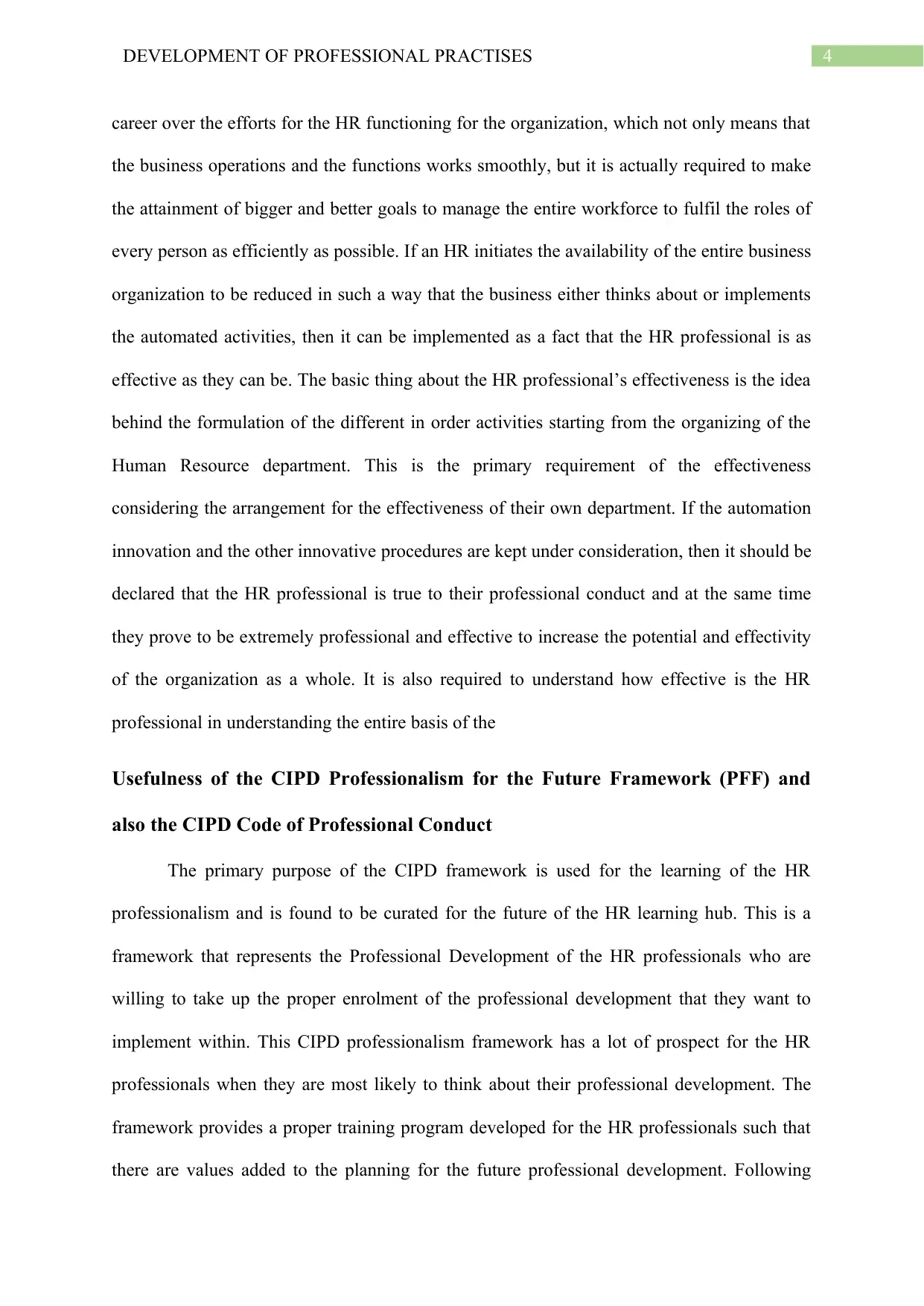
4DEVELOPMENT OF PROFESSIONAL PRACTISES
career over the efforts for the HR functioning for the organization, which not only means that
the business operations and the functions works smoothly, but it is actually required to make
the attainment of bigger and better goals to manage the entire workforce to fulfil the roles of
every person as efficiently as possible. If an HR initiates the availability of the entire business
organization to be reduced in such a way that the business either thinks about or implements
the automated activities, then it can be implemented as a fact that the HR professional is as
effective as they can be. The basic thing about the HR professional’s effectiveness is the idea
behind the formulation of the different in order activities starting from the organizing of the
Human Resource department. This is the primary requirement of the effectiveness
considering the arrangement for the effectiveness of their own department. If the automation
innovation and the other innovative procedures are kept under consideration, then it should be
declared that the HR professional is true to their professional conduct and at the same time
they prove to be extremely professional and effective to increase the potential and effectivity
of the organization as a whole. It is also required to understand how effective is the HR
professional in understanding the entire basis of the
Usefulness of the CIPD Professionalism for the Future Framework (PFF) and
also the CIPD Code of Professional Conduct
The primary purpose of the CIPD framework is used for the learning of the HR
professionalism and is found to be curated for the future of the HR learning hub. This is a
framework that represents the Professional Development of the HR professionals who are
willing to take up the proper enrolment of the professional development that they want to
implement within. This CIPD professionalism framework has a lot of prospect for the HR
professionals when they are most likely to think about their professional development. The
framework provides a proper training program developed for the HR professionals such that
there are values added to the planning for the future professional development. Following
career over the efforts for the HR functioning for the organization, which not only means that
the business operations and the functions works smoothly, but it is actually required to make
the attainment of bigger and better goals to manage the entire workforce to fulfil the roles of
every person as efficiently as possible. If an HR initiates the availability of the entire business
organization to be reduced in such a way that the business either thinks about or implements
the automated activities, then it can be implemented as a fact that the HR professional is as
effective as they can be. The basic thing about the HR professional’s effectiveness is the idea
behind the formulation of the different in order activities starting from the organizing of the
Human Resource department. This is the primary requirement of the effectiveness
considering the arrangement for the effectiveness of their own department. If the automation
innovation and the other innovative procedures are kept under consideration, then it should be
declared that the HR professional is true to their professional conduct and at the same time
they prove to be extremely professional and effective to increase the potential and effectivity
of the organization as a whole. It is also required to understand how effective is the HR
professional in understanding the entire basis of the
Usefulness of the CIPD Professionalism for the Future Framework (PFF) and
also the CIPD Code of Professional Conduct
The primary purpose of the CIPD framework is used for the learning of the HR
professionalism and is found to be curated for the future of the HR learning hub. This is a
framework that represents the Professional Development of the HR professionals who are
willing to take up the proper enrolment of the professional development that they want to
implement within. This CIPD professionalism framework has a lot of prospect for the HR
professionals when they are most likely to think about their professional development. The
framework provides a proper training program developed for the HR professionals such that
there are values added to the planning for the future professional development. Following
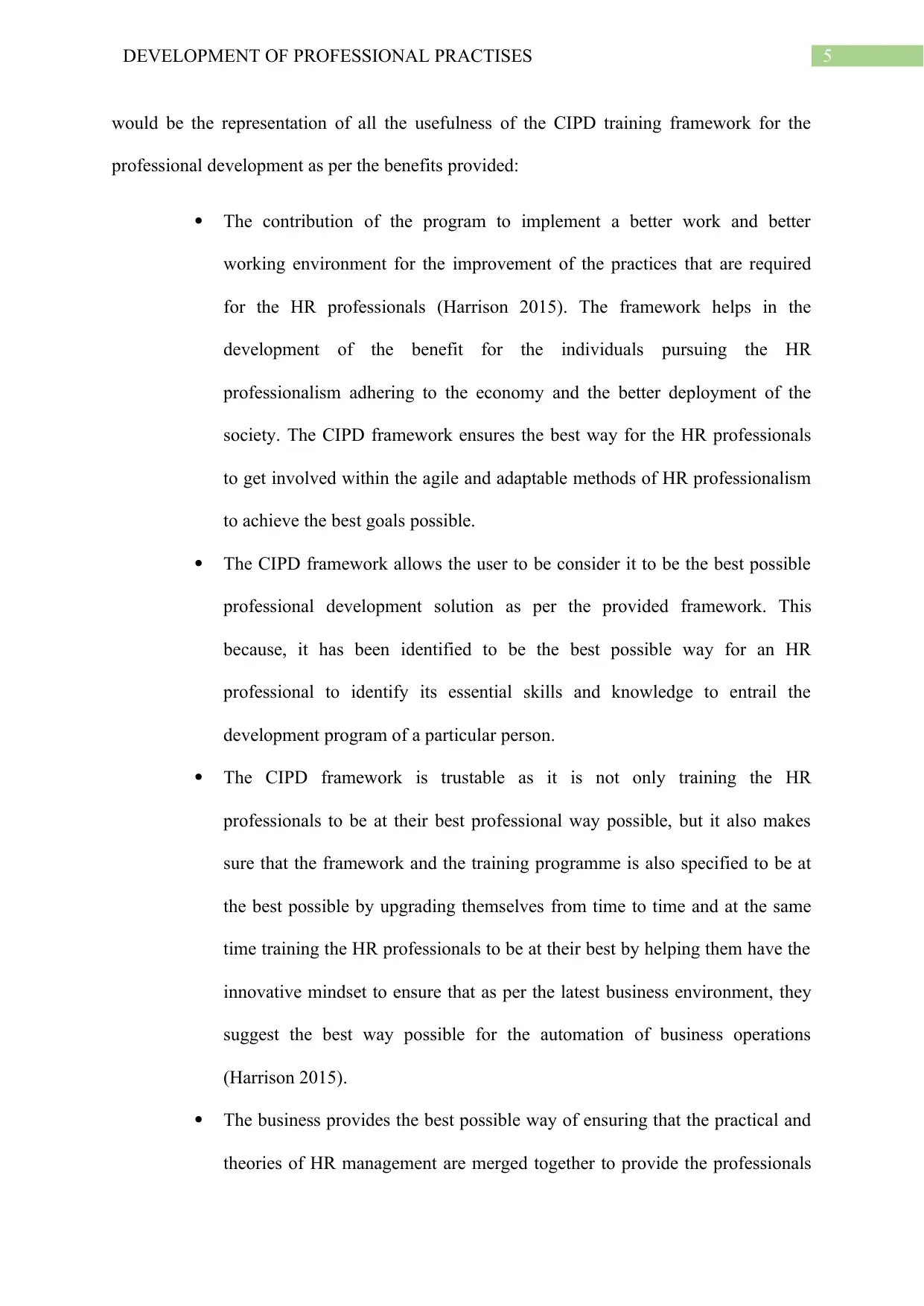
5DEVELOPMENT OF PROFESSIONAL PRACTISES
would be the representation of all the usefulness of the CIPD training framework for the
professional development as per the benefits provided:
The contribution of the program to implement a better work and better
working environment for the improvement of the practices that are required
for the HR professionals (Harrison 2015). The framework helps in the
development of the benefit for the individuals pursuing the HR
professionalism adhering to the economy and the better deployment of the
society. The CIPD framework ensures the best way for the HR professionals
to get involved within the agile and adaptable methods of HR professionalism
to achieve the best goals possible.
The CIPD framework allows the user to be consider it to be the best possible
professional development solution as per the provided framework. This
because, it has been identified to be the best possible way for an HR
professional to identify its essential skills and knowledge to entrail the
development program of a particular person.
The CIPD framework is trustable as it is not only training the HR
professionals to be at their best professional way possible, but it also makes
sure that the framework and the training programme is also specified to be at
the best possible by upgrading themselves from time to time and at the same
time training the HR professionals to be at their best by helping them have the
innovative mindset to ensure that as per the latest business environment, they
suggest the best way possible for the automation of business operations
(Harrison 2015).
The business provides the best possible way of ensuring that the practical and
theories of HR management are merged together to provide the professionals
would be the representation of all the usefulness of the CIPD training framework for the
professional development as per the benefits provided:
The contribution of the program to implement a better work and better
working environment for the improvement of the practices that are required
for the HR professionals (Harrison 2015). The framework helps in the
development of the benefit for the individuals pursuing the HR
professionalism adhering to the economy and the better deployment of the
society. The CIPD framework ensures the best way for the HR professionals
to get involved within the agile and adaptable methods of HR professionalism
to achieve the best goals possible.
The CIPD framework allows the user to be consider it to be the best possible
professional development solution as per the provided framework. This
because, it has been identified to be the best possible way for an HR
professional to identify its essential skills and knowledge to entrail the
development program of a particular person.
The CIPD framework is trustable as it is not only training the HR
professionals to be at their best professional way possible, but it also makes
sure that the framework and the training programme is also specified to be at
the best possible by upgrading themselves from time to time and at the same
time training the HR professionals to be at their best by helping them have the
innovative mindset to ensure that as per the latest business environment, they
suggest the best way possible for the automation of business operations
(Harrison 2015).
The business provides the best possible way of ensuring that the practical and
theories of HR management are merged together to provide the professionals
⊘ This is a preview!⊘
Do you want full access?
Subscribe today to unlock all pages.

Trusted by 1+ million students worldwide
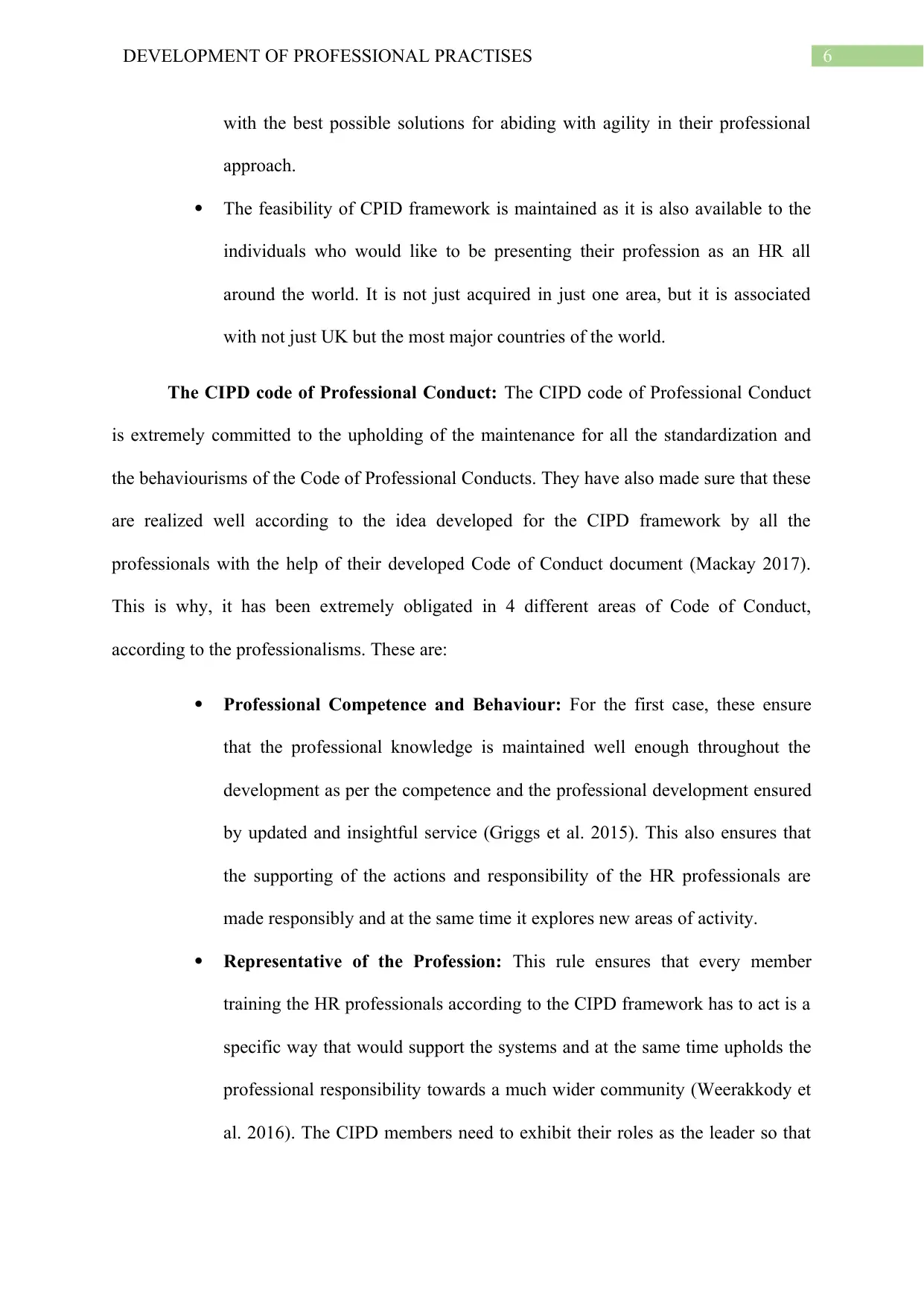
6DEVELOPMENT OF PROFESSIONAL PRACTISES
with the best possible solutions for abiding with agility in their professional
approach.
The feasibility of CPID framework is maintained as it is also available to the
individuals who would like to be presenting their profession as an HR all
around the world. It is not just acquired in just one area, but it is associated
with not just UK but the most major countries of the world.
The CIPD code of Professional Conduct: The CIPD code of Professional Conduct
is extremely committed to the upholding of the maintenance for all the standardization and
the behaviourisms of the Code of Professional Conducts. They have also made sure that these
are realized well according to the idea developed for the CIPD framework by all the
professionals with the help of their developed Code of Conduct document (Mackay 2017).
This is why, it has been extremely obligated in 4 different areas of Code of Conduct,
according to the professionalisms. These are:
Professional Competence and Behaviour: For the first case, these ensure
that the professional knowledge is maintained well enough throughout the
development as per the competence and the professional development ensured
by updated and insightful service (Griggs et al. 2015). This also ensures that
the supporting of the actions and responsibility of the HR professionals are
made responsibly and at the same time it explores new areas of activity.
Representative of the Profession: This rule ensures that every member
training the HR professionals according to the CIPD framework has to act is a
specific way that would support the systems and at the same time upholds the
professional responsibility towards a much wider community (Weerakkody et
al. 2016). The CIPD members need to exhibit their roles as the leader so that
with the best possible solutions for abiding with agility in their professional
approach.
The feasibility of CPID framework is maintained as it is also available to the
individuals who would like to be presenting their profession as an HR all
around the world. It is not just acquired in just one area, but it is associated
with not just UK but the most major countries of the world.
The CIPD code of Professional Conduct: The CIPD code of Professional Conduct
is extremely committed to the upholding of the maintenance for all the standardization and
the behaviourisms of the Code of Professional Conducts. They have also made sure that these
are realized well according to the idea developed for the CIPD framework by all the
professionals with the help of their developed Code of Conduct document (Mackay 2017).
This is why, it has been extremely obligated in 4 different areas of Code of Conduct,
according to the professionalisms. These are:
Professional Competence and Behaviour: For the first case, these ensure
that the professional knowledge is maintained well enough throughout the
development as per the competence and the professional development ensured
by updated and insightful service (Griggs et al. 2015). This also ensures that
the supporting of the actions and responsibility of the HR professionals are
made responsibly and at the same time it explores new areas of activity.
Representative of the Profession: This rule ensures that every member
training the HR professionals according to the CIPD framework has to act is a
specific way that would support the systems and at the same time upholds the
professional responsibility towards a much wider community (Weerakkody et
al. 2016). The CIPD members need to exhibit their roles as the leader so that
Paraphrase This Document
Need a fresh take? Get an instant paraphrase of this document with our AI Paraphraser
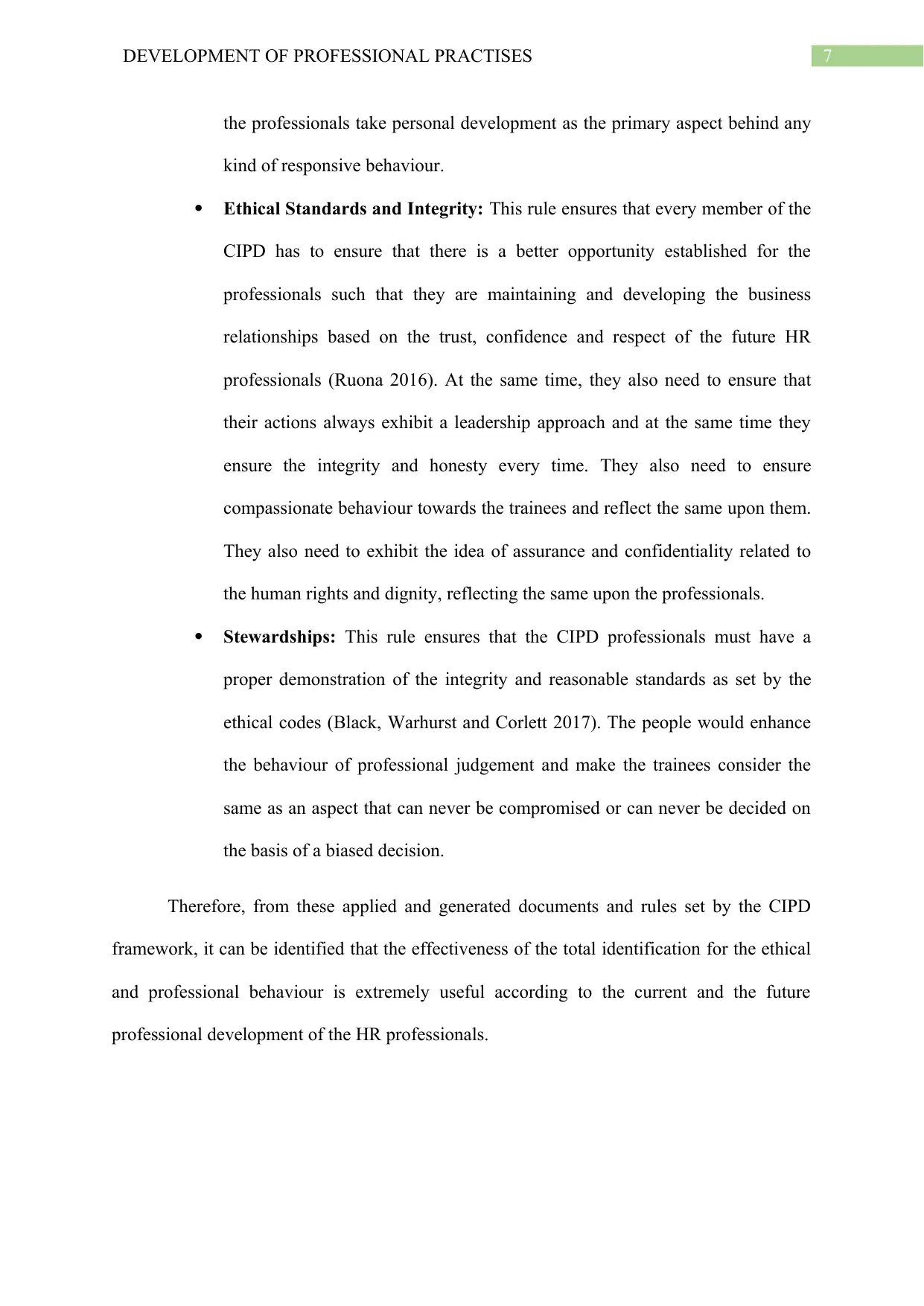
7DEVELOPMENT OF PROFESSIONAL PRACTISES
the professionals take personal development as the primary aspect behind any
kind of responsive behaviour.
Ethical Standards and Integrity: This rule ensures that every member of the
CIPD has to ensure that there is a better opportunity established for the
professionals such that they are maintaining and developing the business
relationships based on the trust, confidence and respect of the future HR
professionals (Ruona 2016). At the same time, they also need to ensure that
their actions always exhibit a leadership approach and at the same time they
ensure the integrity and honesty every time. They also need to ensure
compassionate behaviour towards the trainees and reflect the same upon them.
They also need to exhibit the idea of assurance and confidentiality related to
the human rights and dignity, reflecting the same upon the professionals.
Stewardships: This rule ensures that the CIPD professionals must have a
proper demonstration of the integrity and reasonable standards as set by the
ethical codes (Black, Warhurst and Corlett 2017). The people would enhance
the behaviour of professional judgement and make the trainees consider the
same as an aspect that can never be compromised or can never be decided on
the basis of a biased decision.
Therefore, from these applied and generated documents and rules set by the CIPD
framework, it can be identified that the effectiveness of the total identification for the ethical
and professional behaviour is extremely useful according to the current and the future
professional development of the HR professionals.
the professionals take personal development as the primary aspect behind any
kind of responsive behaviour.
Ethical Standards and Integrity: This rule ensures that every member of the
CIPD has to ensure that there is a better opportunity established for the
professionals such that they are maintaining and developing the business
relationships based on the trust, confidence and respect of the future HR
professionals (Ruona 2016). At the same time, they also need to ensure that
their actions always exhibit a leadership approach and at the same time they
ensure the integrity and honesty every time. They also need to ensure
compassionate behaviour towards the trainees and reflect the same upon them.
They also need to exhibit the idea of assurance and confidentiality related to
the human rights and dignity, reflecting the same upon the professionals.
Stewardships: This rule ensures that the CIPD professionals must have a
proper demonstration of the integrity and reasonable standards as set by the
ethical codes (Black, Warhurst and Corlett 2017). The people would enhance
the behaviour of professional judgement and make the trainees consider the
same as an aspect that can never be compromised or can never be decided on
the basis of a biased decision.
Therefore, from these applied and generated documents and rules set by the CIPD
framework, it can be identified that the effectiveness of the total identification for the ethical
and professional behaviour is extremely useful according to the current and the future
professional development of the HR professionals.
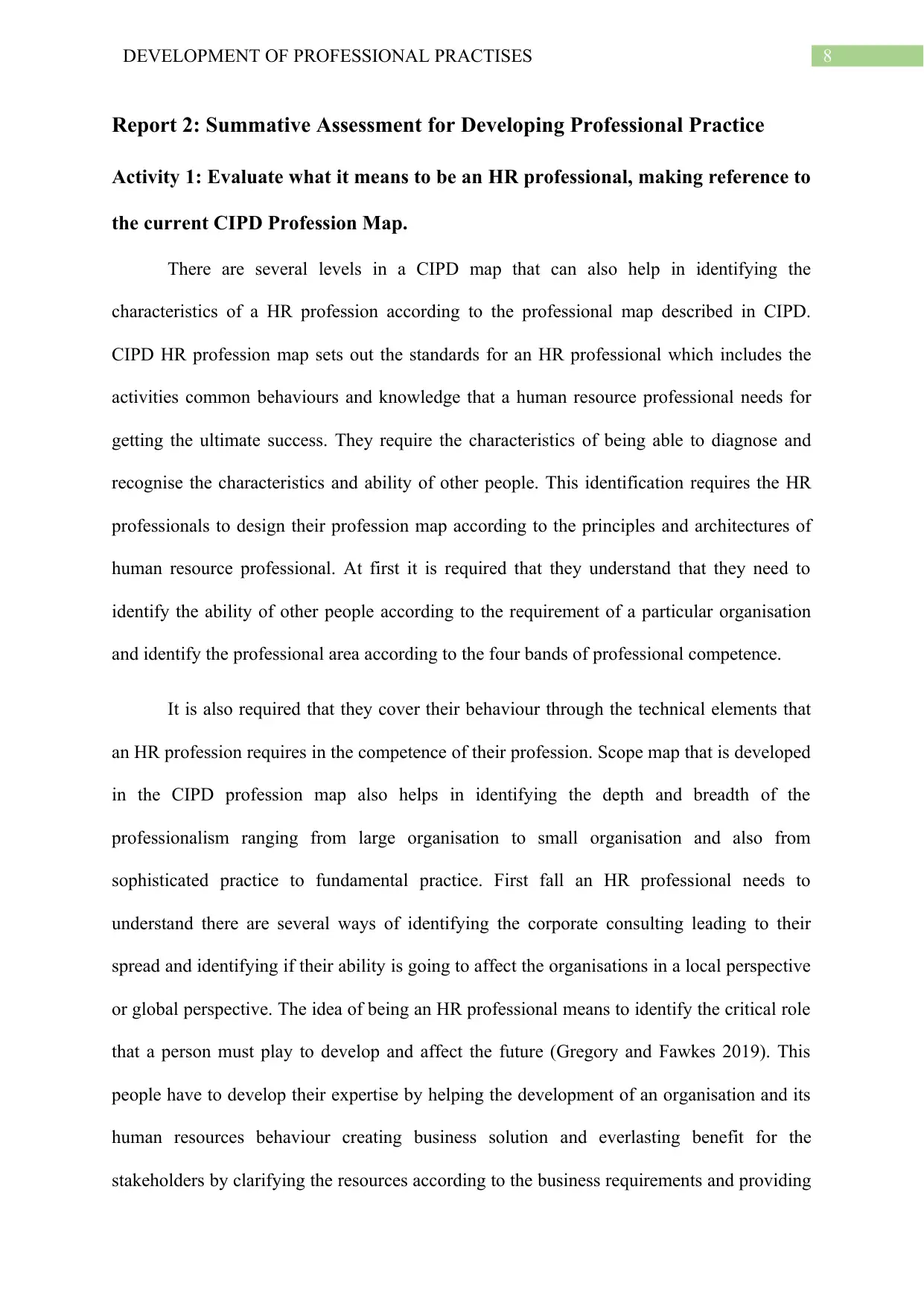
8DEVELOPMENT OF PROFESSIONAL PRACTISES
Report 2: Summative Assessment for Developing Professional Practice
Activity 1: Evaluate what it means to be an HR professional, making reference to
the current CIPD Profession Map.
There are several levels in a CIPD map that can also help in identifying the
characteristics of a HR profession according to the professional map described in CIPD.
CIPD HR profession map sets out the standards for an HR professional which includes the
activities common behaviours and knowledge that a human resource professional needs for
getting the ultimate success. They require the characteristics of being able to diagnose and
recognise the characteristics and ability of other people. This identification requires the HR
professionals to design their profession map according to the principles and architectures of
human resource professional. At first it is required that they understand that they need to
identify the ability of other people according to the requirement of a particular organisation
and identify the professional area according to the four bands of professional competence.
It is also required that they cover their behaviour through the technical elements that
an HR profession requires in the competence of their profession. Scope map that is developed
in the CIPD profession map also helps in identifying the depth and breadth of the
professionalism ranging from large organisation to small organisation and also from
sophisticated practice to fundamental practice. First fall an HR professional needs to
understand there are several ways of identifying the corporate consulting leading to their
spread and identifying if their ability is going to affect the organisations in a local perspective
or global perspective. The idea of being an HR professional means to identify the critical role
that a person must play to develop and affect the future (Gregory and Fawkes 2019). This
people have to develop their expertise by helping the development of an organisation and its
human resources behaviour creating business solution and everlasting benefit for the
stakeholders by clarifying the resources according to the business requirements and providing
Report 2: Summative Assessment for Developing Professional Practice
Activity 1: Evaluate what it means to be an HR professional, making reference to
the current CIPD Profession Map.
There are several levels in a CIPD map that can also help in identifying the
characteristics of a HR profession according to the professional map described in CIPD.
CIPD HR profession map sets out the standards for an HR professional which includes the
activities common behaviours and knowledge that a human resource professional needs for
getting the ultimate success. They require the characteristics of being able to diagnose and
recognise the characteristics and ability of other people. This identification requires the HR
professionals to design their profession map according to the principles and architectures of
human resource professional. At first it is required that they understand that they need to
identify the ability of other people according to the requirement of a particular organisation
and identify the professional area according to the four bands of professional competence.
It is also required that they cover their behaviour through the technical elements that
an HR profession requires in the competence of their profession. Scope map that is developed
in the CIPD profession map also helps in identifying the depth and breadth of the
professionalism ranging from large organisation to small organisation and also from
sophisticated practice to fundamental practice. First fall an HR professional needs to
understand there are several ways of identifying the corporate consulting leading to their
spread and identifying if their ability is going to affect the organisations in a local perspective
or global perspective. The idea of being an HR professional means to identify the critical role
that a person must play to develop and affect the future (Gregory and Fawkes 2019). This
people have to develop their expertise by helping the development of an organisation and its
human resources behaviour creating business solution and everlasting benefit for the
stakeholders by clarifying the resources according to the business requirements and providing
⊘ This is a preview!⊘
Do you want full access?
Subscribe today to unlock all pages.

Trusted by 1+ million students worldwide
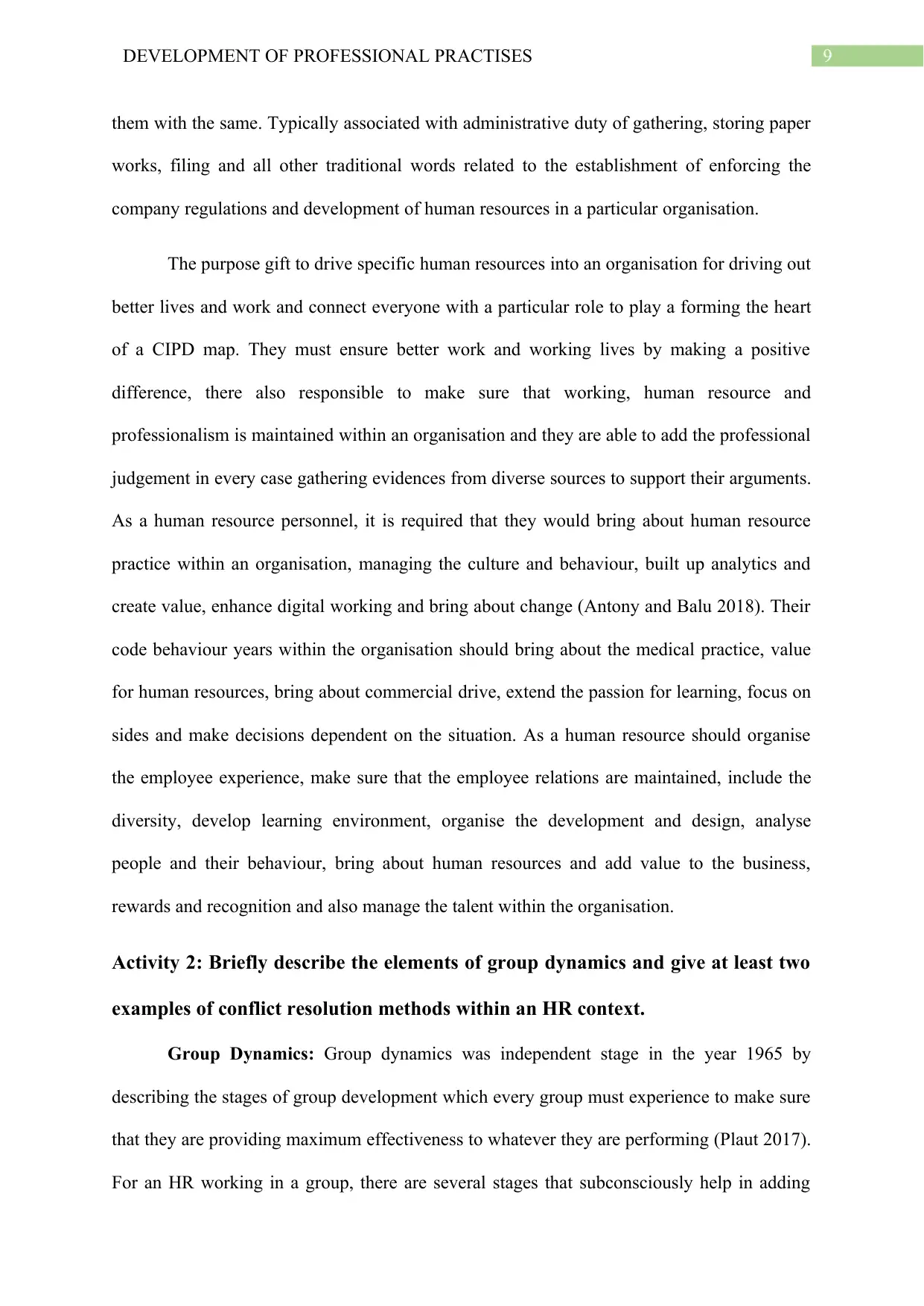
9DEVELOPMENT OF PROFESSIONAL PRACTISES
them with the same. Typically associated with administrative duty of gathering, storing paper
works, filing and all other traditional words related to the establishment of enforcing the
company regulations and development of human resources in a particular organisation.
The purpose gift to drive specific human resources into an organisation for driving out
better lives and work and connect everyone with a particular role to play a forming the heart
of a CIPD map. They must ensure better work and working lives by making a positive
difference, there also responsible to make sure that working, human resource and
professionalism is maintained within an organisation and they are able to add the professional
judgement in every case gathering evidences from diverse sources to support their arguments.
As a human resource personnel, it is required that they would bring about human resource
practice within an organisation, managing the culture and behaviour, built up analytics and
create value, enhance digital working and bring about change (Antony and Balu 2018). Their
code behaviour years within the organisation should bring about the medical practice, value
for human resources, bring about commercial drive, extend the passion for learning, focus on
sides and make decisions dependent on the situation. As a human resource should organise
the employee experience, make sure that the employee relations are maintained, include the
diversity, develop learning environment, organise the development and design, analyse
people and their behaviour, bring about human resources and add value to the business,
rewards and recognition and also manage the talent within the organisation.
Activity 2: Briefly describe the elements of group dynamics and give at least two
examples of conflict resolution methods within an HR context.
Group Dynamics: Group dynamics was independent stage in the year 1965 by
describing the stages of group development which every group must experience to make sure
that they are providing maximum effectiveness to whatever they are performing (Plaut 2017).
For an HR working in a group, there are several stages that subconsciously help in adding
them with the same. Typically associated with administrative duty of gathering, storing paper
works, filing and all other traditional words related to the establishment of enforcing the
company regulations and development of human resources in a particular organisation.
The purpose gift to drive specific human resources into an organisation for driving out
better lives and work and connect everyone with a particular role to play a forming the heart
of a CIPD map. They must ensure better work and working lives by making a positive
difference, there also responsible to make sure that working, human resource and
professionalism is maintained within an organisation and they are able to add the professional
judgement in every case gathering evidences from diverse sources to support their arguments.
As a human resource personnel, it is required that they would bring about human resource
practice within an organisation, managing the culture and behaviour, built up analytics and
create value, enhance digital working and bring about change (Antony and Balu 2018). Their
code behaviour years within the organisation should bring about the medical practice, value
for human resources, bring about commercial drive, extend the passion for learning, focus on
sides and make decisions dependent on the situation. As a human resource should organise
the employee experience, make sure that the employee relations are maintained, include the
diversity, develop learning environment, organise the development and design, analyse
people and their behaviour, bring about human resources and add value to the business,
rewards and recognition and also manage the talent within the organisation.
Activity 2: Briefly describe the elements of group dynamics and give at least two
examples of conflict resolution methods within an HR context.
Group Dynamics: Group dynamics was independent stage in the year 1965 by
describing the stages of group development which every group must experience to make sure
that they are providing maximum effectiveness to whatever they are performing (Plaut 2017).
For an HR working in a group, there are several stages that subconsciously help in adding
Paraphrase This Document
Need a fresh take? Get an instant paraphrase of this document with our AI Paraphraser
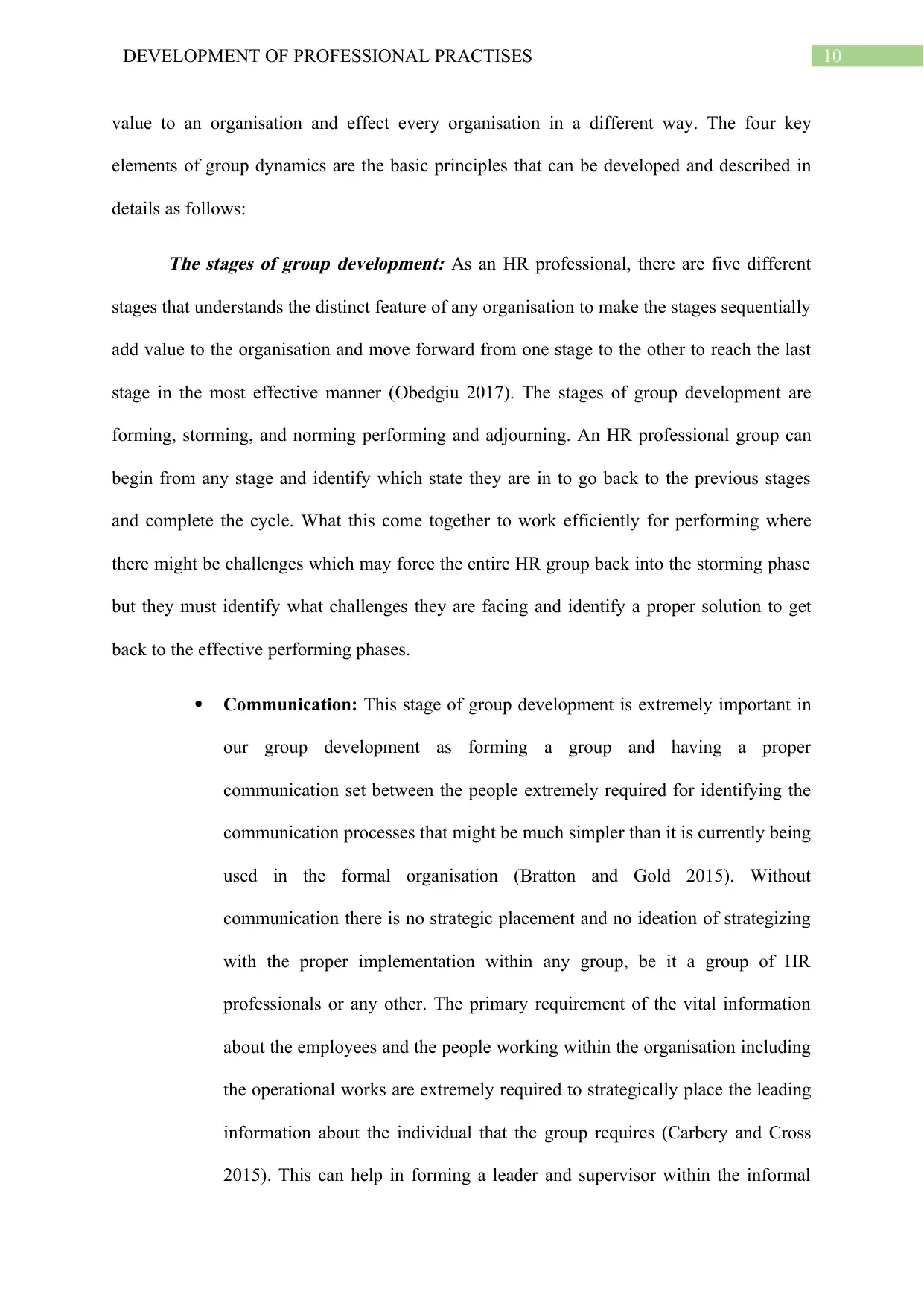
10DEVELOPMENT OF PROFESSIONAL PRACTISES
value to an organisation and effect every organisation in a different way. The four key
elements of group dynamics are the basic principles that can be developed and described in
details as follows:
The stages of group development: As an HR professional, there are five different
stages that understands the distinct feature of any organisation to make the stages sequentially
add value to the organisation and move forward from one stage to the other to reach the last
stage in the most effective manner (Obedgiu 2017). The stages of group development are
forming, storming, and norming performing and adjourning. An HR professional group can
begin from any stage and identify which state they are in to go back to the previous stages
and complete the cycle. What this come together to work efficiently for performing where
there might be challenges which may force the entire HR group back into the storming phase
but they must identify what challenges they are facing and identify a proper solution to get
back to the effective performing phases.
Communication: This stage of group development is extremely important in
our group development as forming a group and having a proper
communication set between the people extremely required for identifying the
communication processes that might be much simpler than it is currently being
used in the formal organisation (Bratton and Gold 2015). Without
communication there is no strategic placement and no ideation of strategizing
with the proper implementation within any group, be it a group of HR
professionals or any other. The primary requirement of the vital information
about the employees and the people working within the organisation including
the operational works are extremely required to strategically place the leading
information about the individual that the group requires (Carbery and Cross
2015). This can help in forming a leader and supervisor within the informal
value to an organisation and effect every organisation in a different way. The four key
elements of group dynamics are the basic principles that can be developed and described in
details as follows:
The stages of group development: As an HR professional, there are five different
stages that understands the distinct feature of any organisation to make the stages sequentially
add value to the organisation and move forward from one stage to the other to reach the last
stage in the most effective manner (Obedgiu 2017). The stages of group development are
forming, storming, and norming performing and adjourning. An HR professional group can
begin from any stage and identify which state they are in to go back to the previous stages
and complete the cycle. What this come together to work efficiently for performing where
there might be challenges which may force the entire HR group back into the storming phase
but they must identify what challenges they are facing and identify a proper solution to get
back to the effective performing phases.
Communication: This stage of group development is extremely important in
our group development as forming a group and having a proper
communication set between the people extremely required for identifying the
communication processes that might be much simpler than it is currently being
used in the formal organisation (Bratton and Gold 2015). Without
communication there is no strategic placement and no ideation of strategizing
with the proper implementation within any group, be it a group of HR
professionals or any other. The primary requirement of the vital information
about the employees and the people working within the organisation including
the operational works are extremely required to strategically place the leading
information about the individual that the group requires (Carbery and Cross
2015). This can help in forming a leader and supervisor within the informal
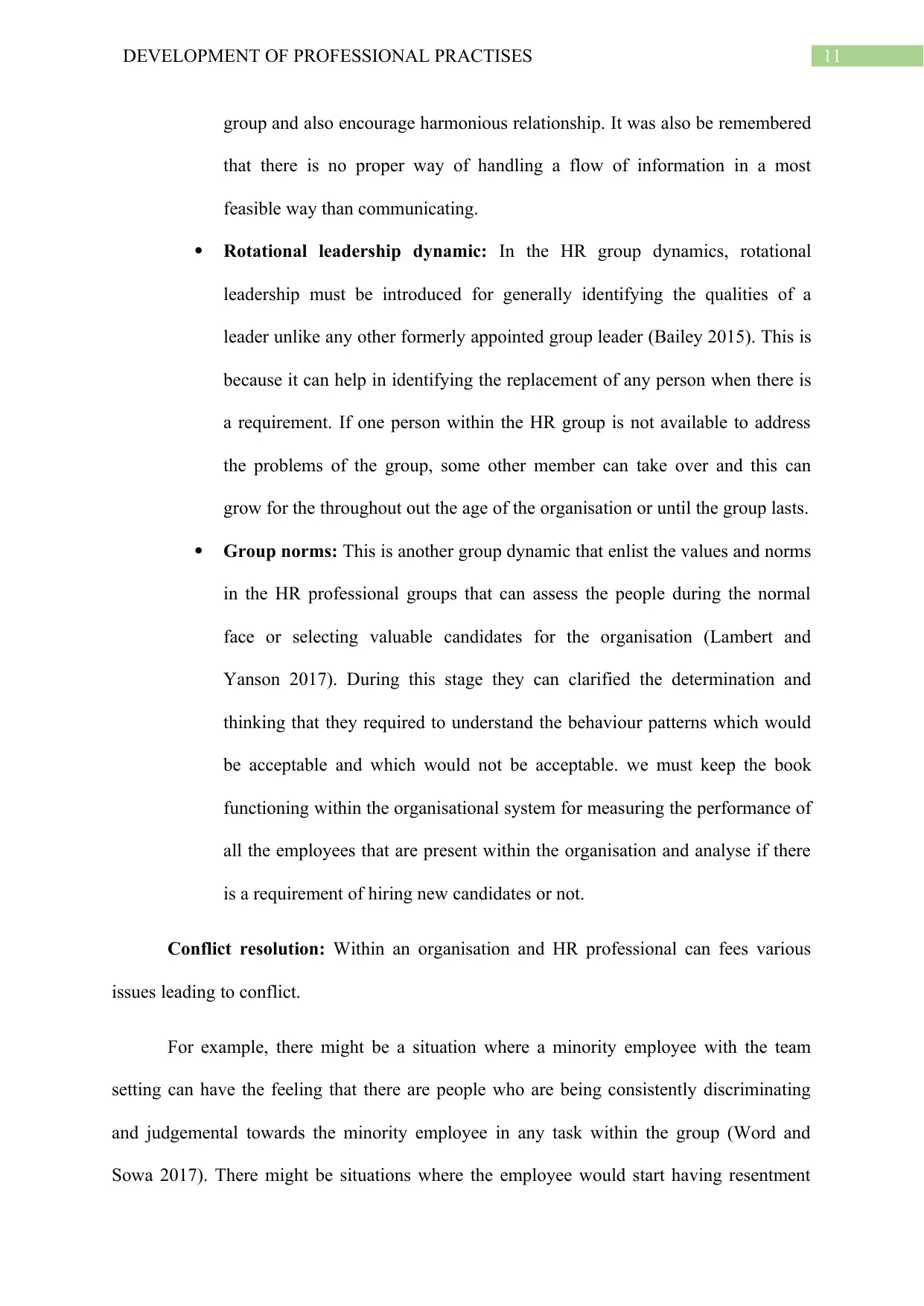
11DEVELOPMENT OF PROFESSIONAL PRACTISES
group and also encourage harmonious relationship. It was also be remembered
that there is no proper way of handling a flow of information in a most
feasible way than communicating.
Rotational leadership dynamic: In the HR group dynamics, rotational
leadership must be introduced for generally identifying the qualities of a
leader unlike any other formerly appointed group leader (Bailey 2015). This is
because it can help in identifying the replacement of any person when there is
a requirement. If one person within the HR group is not available to address
the problems of the group, some other member can take over and this can
grow for the throughout out the age of the organisation or until the group lasts.
Group norms: This is another group dynamic that enlist the values and norms
in the HR professional groups that can assess the people during the normal
face or selecting valuable candidates for the organisation (Lambert and
Yanson 2017). During this stage they can clarified the determination and
thinking that they required to understand the behaviour patterns which would
be acceptable and which would not be acceptable. we must keep the book
functioning within the organisational system for measuring the performance of
all the employees that are present within the organisation and analyse if there
is a requirement of hiring new candidates or not.
Conflict resolution: Within an organisation and HR professional can fees various
issues leading to conflict.
For example, there might be a situation where a minority employee with the team
setting can have the feeling that there are people who are being consistently discriminating
and judgemental towards the minority employee in any task within the group (Word and
Sowa 2017). There might be situations where the employee would start having resentment
group and also encourage harmonious relationship. It was also be remembered
that there is no proper way of handling a flow of information in a most
feasible way than communicating.
Rotational leadership dynamic: In the HR group dynamics, rotational
leadership must be introduced for generally identifying the qualities of a
leader unlike any other formerly appointed group leader (Bailey 2015). This is
because it can help in identifying the replacement of any person when there is
a requirement. If one person within the HR group is not available to address
the problems of the group, some other member can take over and this can
grow for the throughout out the age of the organisation or until the group lasts.
Group norms: This is another group dynamic that enlist the values and norms
in the HR professional groups that can assess the people during the normal
face or selecting valuable candidates for the organisation (Lambert and
Yanson 2017). During this stage they can clarified the determination and
thinking that they required to understand the behaviour patterns which would
be acceptable and which would not be acceptable. we must keep the book
functioning within the organisational system for measuring the performance of
all the employees that are present within the organisation and analyse if there
is a requirement of hiring new candidates or not.
Conflict resolution: Within an organisation and HR professional can fees various
issues leading to conflict.
For example, there might be a situation where a minority employee with the team
setting can have the feeling that there are people who are being consistently discriminating
and judgemental towards the minority employee in any task within the group (Word and
Sowa 2017). There might be situations where the employee would start having resentment
⊘ This is a preview!⊘
Do you want full access?
Subscribe today to unlock all pages.

Trusted by 1+ million students worldwide
1 out of 19
Related Documents
Your All-in-One AI-Powered Toolkit for Academic Success.
+13062052269
info@desklib.com
Available 24*7 on WhatsApp / Email
![[object Object]](/_next/static/media/star-bottom.7253800d.svg)
Unlock your academic potential
Copyright © 2020–2025 A2Z Services. All Rights Reserved. Developed and managed by ZUCOL.



![5DVP: Developing Professional Practice Report - [University Name]](/_next/image/?url=https%3A%2F%2Fdesklib.com%2Fmedia%2Fimages%2Frq%2Fd1f1fed29d4c4b72b622be5f5f3b52cf.jpg&w=256&q=75)

